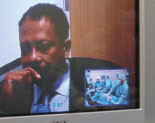Contents
Research Briefs
Connectivity Enables Collaborations
In November 2007, physician-scientist Priscilla Magno practiced new procedures at the Experimental Surgery Laboratory of the University of Puerto Rico (UPR) School of Medicine. One thousand five hundred miles away, her former mentor, Anthony N. Kalloo, chief of the Division of Gastroenterology and Hepatology at the Johns Hopkins Hospital in Baltimore, Md., followed her progress.
Kalloo watched as Magno performed a procedure on an animal model using an endoscope, an instrument used to view organs inside the body. Kalloo was able to observe the same images Magno was seeing in real time and in perfect detail.
The successful long-distance collaboration was made possible by high-resolution video streaming using Internet2, a nonprofit consortium that develops and deploys advanced network applications and technologies for education and high-speed data transfer.
The equipment for Internet2 connectivity and staff positions to operate it were made possible by Research Centers in Minority Institutions (RCMI) funding to the Center for Information Architecture in Research at the UPR Medical Sciences Campus. Additional funding through an NCRR Institutional Development Award provides for an Internet2 network engineer, a key player in the transmission process both before and during the endoscopy procedure.

Anthony N. Kalloo watched researchers at the University of Puerto Rico perform an experimental surgical procedure from his office at the Johns Hopkins Hospital in Maryland. The long-distance collaboration was made possible by high-resolution video streaming using Internet2 connectivity. Photo courtesy of University of Puerto Rico School of Medicine.
The high-resolution, real-time video allowed Magno, who recently returned to UPR from Johns Hopkins, to continue her collaboration with Kalloo in a very tangible way. “We were able to communicate during crucial moments in the procedure,” says Magno. “It was as if he were in the room.”
José G. Conde, director of the Center for Information Architecture in Research, and Aníbal Vega, systems programmer at the center, coordinated the project that made this collaboration possible. Conde hopes that more UPR researchers will utilize the wired surgical suite for collaborative operations and that the use of Internet2 connectivity will expand beyond surgery and be used to promote collaborations for a myriad of research projects.
The establishment of Internet2 connectivity is an ideal example of the mission of the RCMI-funded center: to foster collaborative research and minimize the effect of Puerto Rico’s geographical isolation from major research centers. Conde hopes that this connectivity will bridge the geographical gap and facilitate more training and research to increase and enhance global collaborations at the UPR Medical Sciences Campus.
–Amber Boehm
NCRR Resources: The Research Centers in Minority Institutions program provides grants to institutions that award doctoral degrees in health-related fields and that have a 50 percent or greater enrollment of students from minority communities underrepresented in the biomedical sciences. Through the Institutional Development Award program, NCRR fosters health-related research and improves the competitiveness of investigators in states that historically have not received significant levels of competitive research funding from NIH. For more information, visit www.ncrr.nih.gov/ri.



